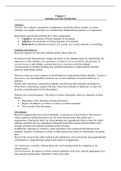Attitudes and Job Satisfaction
Attitudes:
Attitudes are evaluative statements or judgments concerning objects, people, or events.
Attitudes are complex, therefore we consider their fundamental properties or components.
Researchers assume that attitudes have three components:
Cognitive: the opinion of belief segment of an attitude.
Affective: the emotional or feeling segment of an attitude.
Behavioral: an intention to behave in a certain way toward someone or something.
Attitudes and behavior:
Research supports the idea that attitudes predict future behavior.
Several powerful characteristics change the nature of the attitudes-behavior relationship: the
importance of the attitude, correspondence to behavior, its accessibility, the presence of
social pressures, and whether a person has direct experience with the attitude.
Advancements in machine learning have enabled researches to understand the attitude-
behavior relationship further.
However, there are some instances in which behavior might predict future attitudes. Cognitive
dissonance: any incompatibility between two or more attitudes or between behavior or
attitudes.
People seek consistency among their attitudes, and between their attitudes and behavior.
When there is dissonance, people will alter either their attitudes or behaviors, or they will
develop a rationalization for the discrepancy.
Nobody can avoid dissonance. The desire to reduce dissonance, however, depends on three
factors:
Importance of the elements creating dissonance
Degree of influence we believe we have over these elements
The rewards of the dissonance
Job attitudes
Research suggests that across all job attitudes, organizational identification (the extent to
which employees define themselves by the same characteristics that define one’s
organization, forming the basis for which attitudes are engendered) forms a basis for which
attitudes and behaviors are engendered. Research found that organizational identification
strongly predicted job attitude formation across all types.
Furthermore, drawing on AI theory, some researchers have proposed that humans form
attitudes similarly to machines in order to make predictions based on continuously incoming
data.
Much of the research has either looked at job satisfaction, job involvement and organizational
commitment or organizational support and employee engagement.
Job satisfaction: a positive feeling about one’s job resulting from an evaluation of its
characteristics.
Job involvement: the degree to which a person identifies with a job, actively participates in it,
and considers performance important to their self-worth.
, Physical empowerment: employees’ belief in the degree to which they affect their work
environment, their competence, the meaningfulness of their job, and their perceived autonomy
in their work.
Organizational commitment: the degree to which an employee identifies with a particular
organization and its goals and wishes to maintain membership in the organization.
POS Perceived organizational support: the degree to which employees believe an
organization values their contribution and cares about their well-being.
Power distance: a national culture attribute that describes the extent to which a society
accepts that power in institutions and organizations is distributed unequally.
Employee engagement: the degree of enthusiasm an employee feels for the job. Research has
shown that employee engagement is related to employee and organizational performance.
Job satisfaction
There are two popular approaches to measure job satisfaction. One method is to simply ask
how satisfied people are with their job and let them rate it on a scale of 1-5. The other method
is more sophisticated. People are asked to rate the satisfaction on key elements in a job, such
as type of work, skills needed, … both of these methods can be helpful according to research.
There are a few characteristics that influence job satisfaction:
Job conditions: toxic workplace leads to dissatisfied employees. Managers play a big
role in employees’ job satisfaction.
Personality: people who have positive core self-evaluations (believing in one’s inner
worth and basic competence) are more satisfied with their jobs that people with
negative CSEs.
Pay: has influence, but effect can be smaller when an individual reaches a standard
level of comfortable living.
Corporate Social Responsibility: an organization’s commitment to CSR increasingly
affects employee job satisfaction.
Outcome of job satisfaction:
Job performance: happy workers are likely to be more productive.
Organizational Citizenship Behavior (OCB): people who are more satisfied with their
jobs are more likely to engage in citizenship behavior.
Customer satisfaction: satisfied employees appear to increase customer satisfaction
and loyalty.
Life satisfaction: more happy with job, more satisfied with life.
Impact of job dissatisfaction
Exit-voice-loyalty-neglect framework is helpful for understanding the consequences of
dissatisfaction.
Exit response: directs behavior toward leaving the organization/looking for a new
position or resigning. To measure the effects of this response to dissatisfaction,
researches study individual terminations and collective turnover.
Voice response: actively and constructively attempting to improve conditions.
Loyalty response: passively but optimistically waiting for conditions to improve.
Neglect response: passively allows conditions to worsen and includes chronic
absenteeism or lateness, reduced effort, and an increased error rate.



